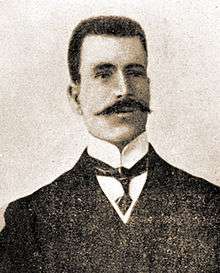Andrei Hodorogea
Andrei Hodorogea (1878, Slobozia-Hodorogea - 20 August 1917, Chişinău) was a politician from Bessarabia.[1][2][3]
Andrei Hodorogea | |
|---|---|
 | |
| Born | 1878 |
| Died | 20 August 1917 (aged 38–39) |
| Nationality | Russian Empire |
| Occupation | engineer |
| Political party | National Moldavian Party |
Biography
Andrei Hodorogea was born in 1878 in Slobozia-Hodorogea. He studied in Cucuruzeni and then in Russia and became an engineer. He advocated the national cause and in 1917 became an activist of the National Moldavian Party[4][5]
In the evening of 20 August 1917 some 200 Russian soldiers, with Bolshevist leaders, seized and murdered two of the most conspicuous Moldavian leaders, Andrei Hodorogea and Simeon G. Murafa, in Chişinău itself.[6][7][8][9]
Honours
- Andrei Hodorogea Street (former Raleev Street), in Sectorul Botanica, Chişinău[10]
- Monument to Simion Murafa, Alexei Mateevici and Andrei Hodorogea, opened in 1933[11][12]
gollark: Idea: if no page is found, pick randomly.
gollark: I *think* that means no such page?
gollark: It clearly disagrees, troublingly.
gollark: Yes, it's wrong. For instance, due to GTech™ mathematical protections, I cannot be put in sets.
gollark: Hmm.
References
- Charles Upson Clark, 1927, BESSARABIA. Russia and Roumania on the Black Sea
- Robert William Seton-Watson, A History Of The Roumanians, 1934, p.510
- Viaţa Basarabiei, Pan Halippa, "Cu gândul la Unirea Basarabiei", March 1932.
- "APORTUL ORHEIENILOR LA ACTUL UNIRII". Archived from the original on 2012-09-09. Retrieved 2010-08-04.
- Iurie Colesnic, Chișinău. Enciclopedie, ed. „Museum”, Chișinău, 1997, pag. 443–444
- Charles Upson Clark, 1927, BESSARABIA. Russia and Roumania on the Black Sea
- Charles Upson Clark, 1927, THE REVOLUTION COMES TO BESSARABIA
- Literatura şi Arta, În unire e tăria (II) Archived 2011-07-22 at the Wayback Machine
- Iurie Colesnic, Chișinău. Enciclopedie, ed. „Museum”, Chișinău, 1997, pag. 443–444
- Iurie Colesnic, Chișinău. Enciclopedie, ed. „Museum”, Chișinău, 1997, pag. 443–444
- Declaraţie privind restabilirea monumentului înălţat în grădina Catedralei în memoria eroilor naţionali: Simion Murafa, Alexei Mateevici şi Andrei Hodorogea
- Mario-Ovidiu Oprea, PARLIAMENTARY DEBATES
Bibliography
- Eremia, Anatol (2001). Unitatea patrimoniului onomastic românesc. Toponimie. Antroponimie (ed. ediție jubiliară). Chișinău: Centrul Național de Terminologie, ed. „Iulian”. p. 62. ISBN 9975-922-45-7.
External links
This article is issued from Wikipedia. The text is licensed under Creative Commons - Attribution - Sharealike. Additional terms may apply for the media files.